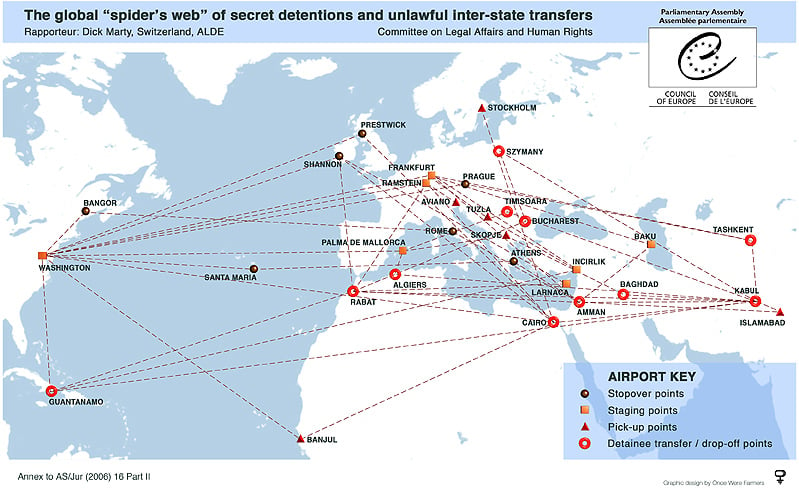This is what Complicity looks like
A web of collusion tethered to four continents, ensnaring the world: a secretive geography of fear.

It is a perverse reflection of the forced immobility of refugees. Those who flee torture are held paralysed in the static limbo of the detention centre, the temporary hostel, the holding pen. Those whom certain client states (doubtless for reasons of political expediency and the preservation of ‘special relationships’) consent to persecute are forced into flight. Not flight from torture but towards it. And – in some cases at least – they are not flown far. In the cautiously discrete words of Dick Marty, “a number of coherent and converging elements indicate that secret detention centres did indeed exist in Europe.” Dick Marty Council of Europe Parliamentary Assembly, Committee on Legal Affairs and Human Rights Alleged Secret Detentions and unlawful inter-state transfers involving Council of Europe Member States ( Draft Report Part II , June 2006, 1.8.23). It is thought that Rumania and Poland currently harbour secret CIA detention centres.
The chief-spider-in-charge officially began the weaving of this web in the mid-1990s. The programme was devised under Clinton by Michael Scheuer (who remained in the employ of the C.I.A. until November 2004) as a way of taking “terrorist suspects in foreign countries ‘off the streets’ by transporting them back to other countries, where they were wanted for trial, or for detention without any form of due process.” (Marty, 2.26)
Rendition. It’s a lovely word in its way, doubtless chosen with exquisite care. On its surface it’s merely another mealy-mouthed euphemism: kissing cousin to ‘collateral damage,’ ‘surgical strike’ and ‘shoot to incapacitate.’ But as Naomi Klein and others before her have observed, torture is predicated upon a ‘knowing / not knowing.’ It is a secret that is really no secret at all: a “semi-clandestine institution” (Sartre, “A Victory” Colonialism and Neo-Colonialism ). And herein lies the particular appropriateness of ‘rendition’ for it is a semi-clandestine word. Though bland enough on its surface, it bears the resonance of other meanings (albeit philologically distinct): to rend – to tear with violent force; to render – to extract (fat) by melting (meat).
And in selecting as his leitmotif the spider's web, Marty chose well. For even the process by which prisoners are ‘prepared’ with a ‘security check’ for ‘rendition’ bears a grotesque resemblance to the spider’s systematic entombment of its prey.
Usually, what awaits them on arrival at that unknown destination is a secretive indefinite detention, profound isolation and torture.
Go.
Read the whole report It does not take long.
See for yourself the complicity of the colonies, the collusion of the client-states, set forth in calm judicious (though alas, not judicial) tones.

It is a perverse reflection of the forced immobility of refugees. Those who flee torture are held paralysed in the static limbo of the detention centre, the temporary hostel, the holding pen. Those whom certain client states (doubtless for reasons of political expediency and the preservation of ‘special relationships’) consent to persecute are forced into flight. Not flight from torture but towards it. And – in some cases at least – they are not flown far. In the cautiously discrete words of Dick Marty, “a number of coherent and converging elements indicate that secret detention centres did indeed exist in Europe.” Dick Marty Council of Europe Parliamentary Assembly, Committee on Legal Affairs and Human Rights Alleged Secret Detentions and unlawful inter-state transfers involving Council of Europe Member States ( Draft Report Part II , June 2006, 1.8.23). It is thought that Rumania and Poland currently harbour secret CIA detention centres.
The chief-spider-in-charge officially began the weaving of this web in the mid-1990s. The programme was devised under Clinton by Michael Scheuer (who remained in the employ of the C.I.A. until November 2004) as a way of taking “terrorist suspects in foreign countries ‘off the streets’ by transporting them back to other countries, where they were wanted for trial, or for detention without any form of due process.” (Marty, 2.26)
Rendition. It’s a lovely word in its way, doubtless chosen with exquisite care. On its surface it’s merely another mealy-mouthed euphemism: kissing cousin to ‘collateral damage,’ ‘surgical strike’ and ‘shoot to incapacitate.’ But as Naomi Klein and others before her have observed, torture is predicated upon a ‘knowing / not knowing.’ It is a secret that is really no secret at all: a “semi-clandestine institution” (Sartre, “A Victory” Colonialism and Neo-Colonialism ). And herein lies the particular appropriateness of ‘rendition’ for it is a semi-clandestine word. Though bland enough on its surface, it bears the resonance of other meanings (albeit philologically distinct): to rend – to tear with violent force; to render – to extract (fat) by melting (meat).
And in selecting as his leitmotif the spider's web, Marty chose well. For even the process by which prisoners are ‘prepared’ with a ‘security check’ for ‘rendition’ bears a grotesque resemblance to the spider’s systematic entombment of its prey.
85. The general characteristics of this “security check” can be established from a host of testimonies as follows:
i. it generally takes place in a small room (a locker room, a police reception area) at the airport, or at a transit facility nearby.
ii. the man is sometimes already blindfolded when the operation begins, or will be blindfolded quickly and remain so throughout most of the operation.
iii. four to six CIA agents perform the operation in a highly-disciplined, consistent fashion – they are dressed in black (either civilian clothes or special 'uniforms'), wearing black gloves, with their full faces covered. Testimonies speak, variously, of “big people in black balaclavas”, people “dressed in black like ninjas”, or people wearing “ordinary clothes, but hooded”.
iv. the CIA agents “don’t utter a word when they communicate with one another”, using only hand signals or simply knowing their roles implicitly.
v. some men speak of being punched or shoved by the agents at the beginning of the operation in a rough or brutal fashion; others talked about being gripped firmly from several sides
vi. the man’s hands and feet are shackled.
vii. the man has all his clothes (including his underwear) cut from his body using knives or scissors in a careful, methodical fashion; an eye-witness described how “someone was taking these clothes and feeling every part, you know, as if there was something inside the clothes, and then putting them in a bag”.
viii. the man is subjected to a full-body cavity search, which also entails a close examination of his hair, ears, mouth and lips.
ix. the man is photographed with a flash camera, including when he is nearly or totally naked; in some instances, the man's blindfold may be removed for the purpose of a photograph in which his face is also identifiable.
x. some accounts speak of a foreign object being forcibly inserted into the man's anus; some accounts speak more specifically of a tranquiliser or suppository being administered per rectum - in each description this practice has been perceived as a grossly violating act that affronts the man’s dignity.
xi. the man is then dressed in a nappy or incontinence pad and a loose-fitting "jump-suit" or set of overalls; “they put diapers on him and then there is some handling with these handcuffs and foot chains, because first they put them on and then they are supposed to put him in overalls, so then they have to alternately unlock and relock them”.
xii. the man has his ears muffled, sometimes being made to wear a pair of "headphones"
xiii. finally a cloth bag is placed over the man's head, with no holes through which to breathe or detect light; they “put a blindfold on him and after that a hood that apparently reaches far down on his body” .
xiv. the man is typically forced aboard a waiting aeroplane, where he may be “placed on a stretcher, shackled”, or strapped to a mattress or seat, or “laid down on the floor of the plane and they bind him up in a very uncomfortable position that makes him hurt from moving”.
xv. in some cases the man is drugged and experiences little or nothing of the actual rendition flight; in other cases, factors such as the pain of the shackles or the refusal to drink water or use the toilet make the flight unbearable: “this was the hardest moment in my life”.
xvi. in most cases, the man has no notion of where he is going, nor the fate that awaits him upon arrival.
Marty, 2.7.1.85
Usually, what awaits them on arrival at that unknown destination is a secretive indefinite detention, profound isolation and torture.
Go.
Read the whole report It does not take long.
See for yourself the complicity of the colonies, the collusion of the client-states, set forth in calm judicious (though alas, not judicial) tones.



2 Comments:
The chief-spider-in-charge officially began the weaving of this web in the mid-1990s. The programme was devised under Clinton by Michael Scheuer
Having read both of Scheuer's books I'm blown away to learn he's the architect of this horror. I just figured him to be one of the "good ones". Like Bob Baer or Larry Johnson. Wow was I ever wrong.
In many ways, I think there are more continuities in U.S. foreign policy than than disjunctures -- I think that from the outside, the general thrust of U.S. foreign policy seems relatively consistent regardless of who is in power -- so the idea that this policy was devised under Clinton doesn't surprise. (Not that there aren't points of difference, just that these are less salient than the similarities).
The institutional character of the CIA is one of those points of continuity, I think -- or at least appears as one from beyond the border. I guess what I'm trying to circumlocute my way around is that I don't think this is an institution where there are any 'good ones'per se.
Scheuer did cooperate with Marty and go on record though, which may indicate some kind of remorse.
Anyway -- very nice to see you here
Post a Comment
<< Home